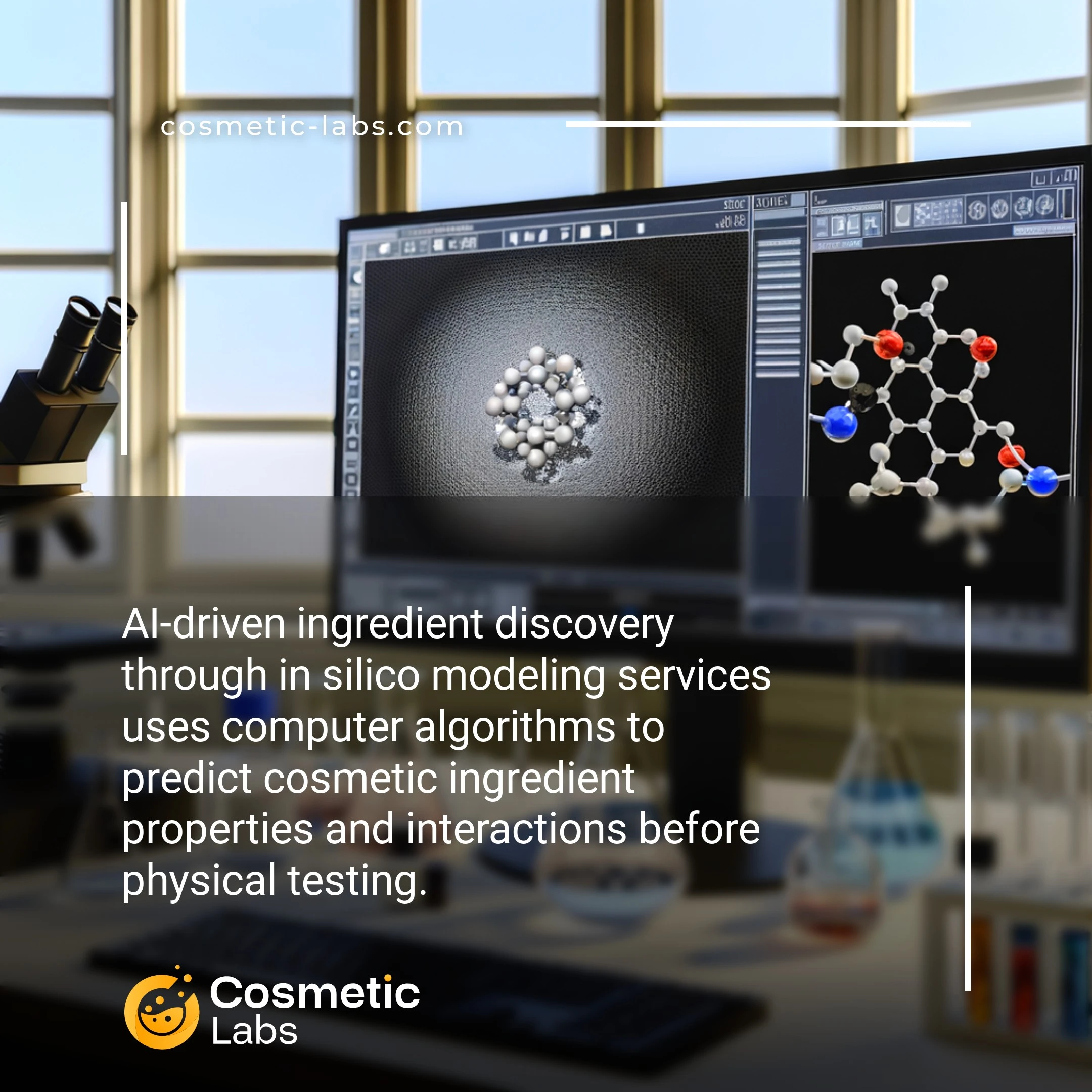AI Ingredient Discovery Services Through In Silico Modeling

What is AI-driven ingredient discovery through in silico modeling?
AI-driven ingredient discovery through in silico modeling services uses machine learning algorithms and computational chemistry to predict how new cosmetic ingredients will behave before physical testing. Labs on our platform run molecular dynamics simulations and QSAR modeling to screen thousands of potential actives for skin penetration, stability, and efficacy within weeks rather than months of traditional lab work.
Why do you need this service?
Cosmetic labs use molecular docking simulations to predict how new peptides and botanical extracts will interact with skin receptors before synthesis, cutting ingredient development timelines from months to weeks. Teams also apply QSAR modeling to screen thousands of potential anti-aging compounds virtually, identifying the most promising candidates for targeted efficacy testing while reducing lab costs by up to 60%.
Who provides AI-driven ingredient discovery through in silico modeling services?
All cosmetic labs providing AI-driven ingredient discovery through in silico modeling services
There is no company providing these services at the moment.
AI-Driven Ingredient Discovery Through In Silico Modeling Services
Cosmetic labs now use AI-driven ingredient discovery to identify promising compounds before physical testing begins. This computational approach reduces development time by 40-60% while predicting ingredient behavior, safety profiles, and efficacy potential through advanced molecular modeling.
Predictive Molecular Analysis and Safety Screening
Labs run predictive algorithms that analyze molecular structures to forecast skin penetration, irritation potential, and stability profiles. These models screen thousands of compounds in weeks rather than months of lab work.
Key screening capabilities include:
- Dermal absorption prediction models
- Allergenicity risk assessment
- Photostability analysis
- pH compatibility testing
This approach helps brands avoid costly reformulations by identifying potential issues before prototype development.
Efficacy Prediction and Formulation Optimization
Advanced machine learning models predict how ingredients interact with skin proteins and cellular pathways. Labs use these insights to optimize concentrations and identify synergistic combinations that enhance product performance.
Modeling services typically cover:
- Anti-aging pathway analysis
- Moisturization mechanism prediction
- Antioxidant activity forecasting
- Ingredient compatibility mapping
Connect with specialized labs on our platform to access these computational discovery services and accelerate your product development timeline.
Practical Applications of AI-Driven Ingredient Discovery Through In Silico Modeling
Cosmetic labs use AI-driven ingredient discovery through in silico modeling to predict molecular behavior, optimize formulations, and reduce development timelines from months to weeks.
Predictive Skin Penetration Analysis
Labs run molecular dynamics simulations to predict how active ingredients penetrate skin barriers before physical testing. These models analyze molecular weight, lipophilicity, and hydrogen bonding patterns to forecast dermal absorption rates with 85-92% accuracy.
QSAR (Quantitative Structure-Activity Relationship) algorithms identify optimal molecular modifications for enhanced bioavailability. Teams can screen 10,000+ molecular variants in silico within 48 hours, compared to 6-8 months for traditional lab screening.
| Modeling Approach | Prediction Accuracy | Time to Results | Cost per Analysis |
|---|---|---|---|
| Molecular Dynamics | 88-95% | 24-72 hours | $500-800 |
| QSAR Models | 82-89% | 2-6 hours | $200-400 |
| Machine Learning | 85-92% | 1-4 hours | $150-300 |
Anti-Aging Compound Optimization
AI models predict collagen synthesis enhancement and elastin degradation inhibition for anti-aging actives. Labs use protein-ligand docking simulations to identify compounds that bind effectively to matrix metalloproteinases (MMPs) and collagenase enzymes.
Machine learning algorithms trained on 50,000+ molecular structures predict anti-inflammatory activity and photoprotection properties. This approach reduces ingredient screening costs by 70% while identifying novel peptide sequences and botanical extracts with superior efficacy profiles.
Ready to accelerate your ingredient discovery process? Contact specialized cosmetic labs on our platform to explore AI-driven modeling services tailored to your formulation needs.
